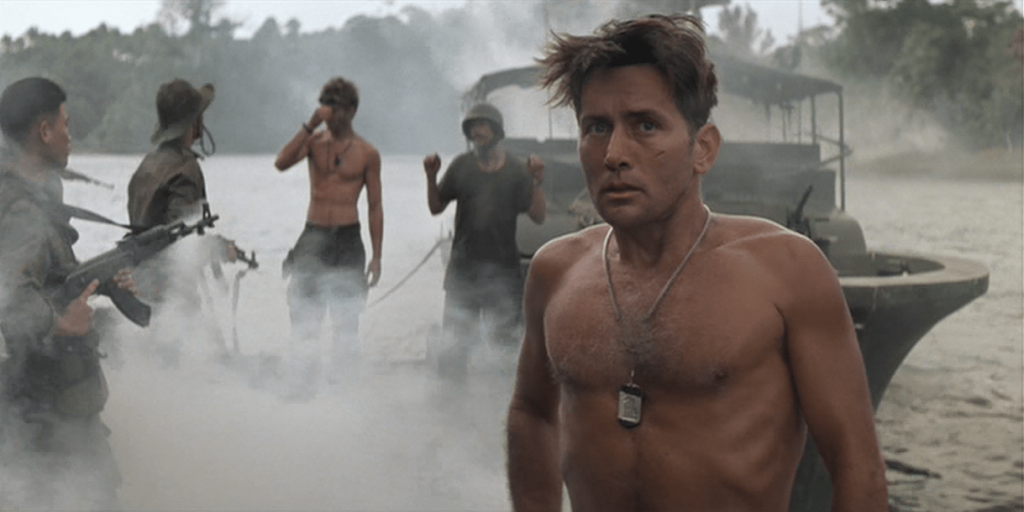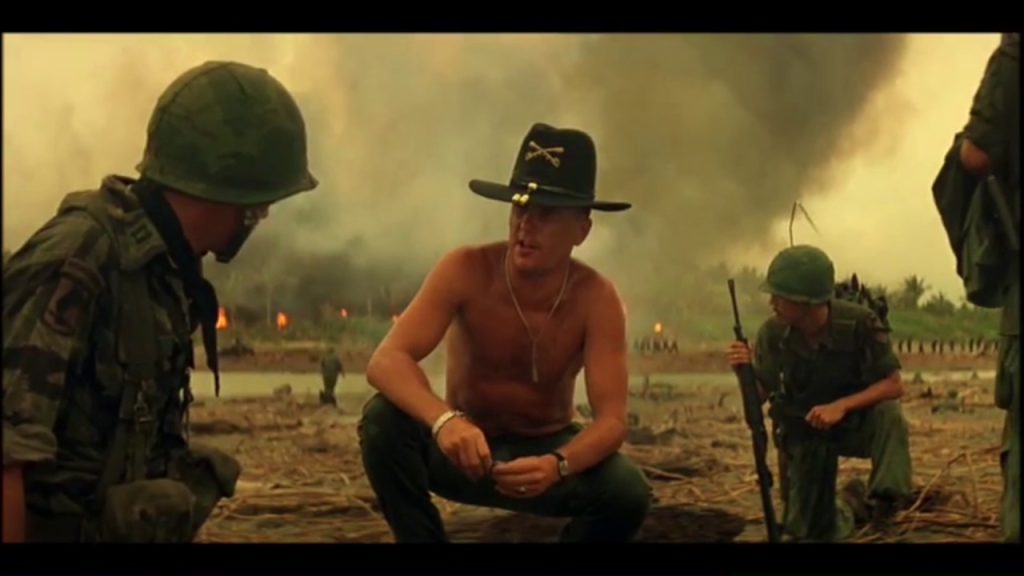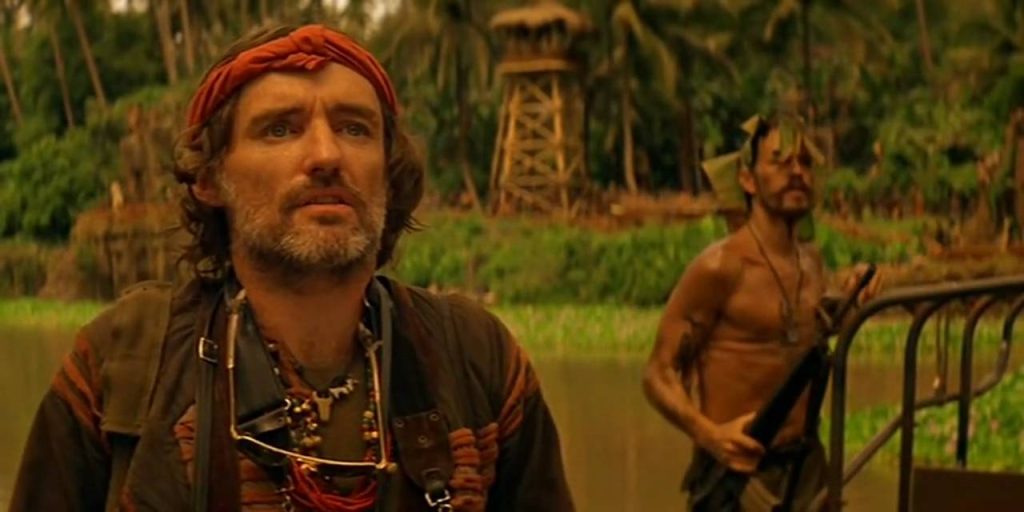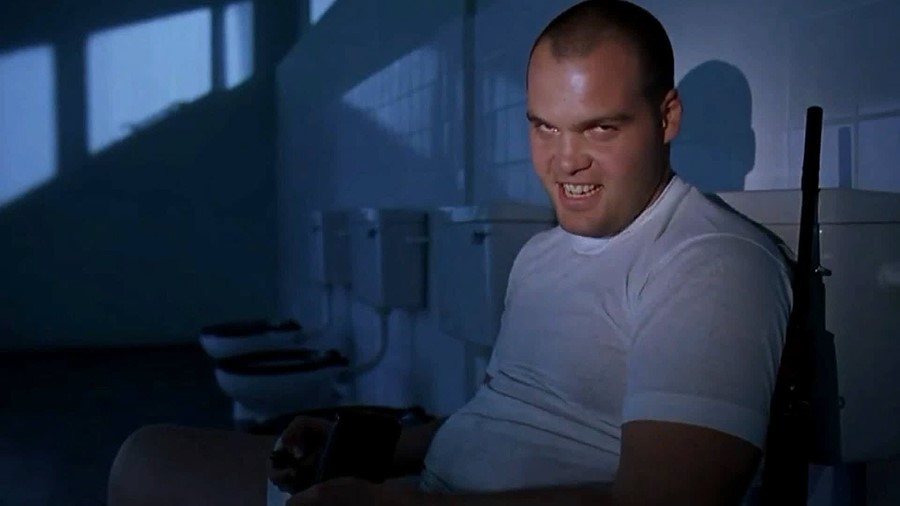
“War is hell,” the cliche’ proclaims, but it seems to be entertaining hell. Along with other ghastly subjects such as murder and vampirism, war ranks among the most popular and commonly used subject matter of filmed entertainment, and no war has yielded more or better films than the one in Vietnam between 1955 and 1975. Whether detailing the effects of the war by studying its aftermath or getting right into the heart of the battles, the Vietnam War has proven to be a source of boundless interest for filmmakers and moviegoers alike. Perhaps it is the moral ambiguity of Vietnam that makes it the most interesting war for film adaptations, and no films illustrate this ambiguity better than Francis Ford Coppola’s Apocalypse Now and Stanley Kubrick’s Full Metal Jacket.
Apocalypse Now was the first and still, arguably, the best movie to take place in the midst of the war itself, shot shortly after its ending in the mid-1970s and released on the brink of the Reagan era in 1979. [EDITOR’S NOTE: Try Tigerland] Inspired by Joseph Conrad’s Heart of Darkness, Coppola and screenwriter John Milius supplant the metaphorical journey of that novella’s central character from 1890s Africa to the Southeast Asian jungle of the 1960s. Intimately tied to this shift in viewpoint is that, while Heart of Darkness’s narrator, Charlie Marlowe, begins as a sane and stable man who faces madness and the inherent evil of mankind in the form of Mister Kurtz, Apocalypse Now‘s narrator, Benjamin Willard (Martin Sheen), has already been driven at least to the verge of madness by his previous Vietnam experience before the beginning of the film. This change of perspective suggests that morality and sanity had become much more tentative and ambiguous in the time of the Vietnam War.

At the 1979 Cannes Film Festival premiere of the movie, Coppola stated that “My film is not about Vietnam; my film is Vietnam.” We are thrust into a world of madness with no moral center, an apt vision of conditions in the Vietnam War. This intention is evidenced not only by the chaotic and violent nature of the entire film, but also in the decision to make the story’s narrator a madman, thereby depriving the viewer of a more traditionally relatable gateway into the story.
Just as the film itself “is Vietnam” in macrocosm, three of its central characters also are Vietnam in microcosm: Willard, Colonel Kurtz (Marlon Brando), and Captain Kilgore (Robert Duvall). Willard has been in the jungle so much it has become who he is; he says of Vietnam, “When I was here I wanted to be there. When I was there, all I could think of was getting back into the jungle.” Kurtz and Kilgore are two sides of the same coin, the soldier gone mad from the madness of war. Kilgore is the joyful madman who revels in battle (“I love the smell of napalm in the morning,” he says in one of the most famous scenes. “Smells like victory”) and has managed to keep a tenable position in the military despite randomly decimating entire villages, to the tune of Wagner’s “Flight of the Valkyries,” for the sole purpose of clearing a neighboring beach so that he and his men can go surfing.

Critic Michael Wood, in his article “Bangs and Whispers” from the October 1979 New York Review of Books, asserts that Kilgore should have been the Kurtz figure of the film, a man so flamboyantly insane that he provides a clear counterpoint to Sheen’s Willard, but the closer similarities between Willard and Brando’s Kurtz hint at a metaphorical journey of Willard into himself, into the darkest reaches of his own soul, that echoes his literal journey downriver to Kurtz’s lair. When he completes his assignment by killing Kurtz, he has perhaps silenced the encroaching darkness in his own heart.
Apocalypse Now‘s overall vision of madness (from Willard to Kilgore to Kurtz, along with fascinating side characters such as Sam Bottoms’s LSD-abusing surfer/soldier and Dennis Hopper’s fanatical photojournalist) paints a disturbing picture not only of the Vietnam experience, but of all humanity in a world that made the atrocities of Vietnam possible. As Coppola himself says about the making of the film in the 1991 documentary Hearts of Darkness: A Filmmaker’s Apocalypse, “We were out there with too much equipment, too much money and too much time… and we all went a little insane,” which can be seen as an astute criticism of America’s position in the war itself. Ultimately, Apocalypse Now is more than merely a war movie, which may be why many critics consider it the best war movie ever made, and perhaps even the greatest American film of any kind.

Full Metal Jacket has also been “acclaimed by critics around the world as the best war movie ever made,” according to the 1990 home video release. Though it could be argued that Apocalypse Now is a greater cinematic achievement, it is less tenable to say that it is more true-to-life. Apocalypse Now is highly stylized and subjective, while Full Metal Jacket has a distinct documentary feel, despite its often stunning cinematography and use of stylistic devices such as slow-motion. These approaches reflect the background of each director: Kubrick began with documentaries like “Flying Padre” (1951), while Coppola got his start at B-movie producer Roger Corman’s American-International Pictures.
Full Metal Jacket‘s more objective, realistic perspective also reflects the point-of-view of its protagonist and narrator, Private Joker (Matthew Modine), who goes through Marine training to become a field reporter in Vietnam. Though Joker is a much more sane and rational character than Willard, he too is deeply corrupted by his experience, as he becomes more and more cynical throughout the movie. As he says at one point, in the persona of John Wayne, “A day without blood is like a day without sunshine.” This cynical loss of innocence is a cohesive underlying theme in the film, which, like Apocalypse Now, is a journey into the heart of darkness. This is established in the opening sequence, which shows its various characters having their heads shaved, set to the tune of a song called “Hello Vietnam.” Full Metal Jacket is, essentially, a coming-of-age story (albeit a very brutal one) that is divided into two self-contained, but connected, stories within the film.

The first story thrusts the viewer into the rigid, violent life of Marine training camp and, though Joker is established as the protagonist from the start, the central character of this first story is actually Leonard Lawrence (Vincent D’Onofrio). Leonard, dubbed “Gomer Pyle” by sadistic drill instructor Sgt. Hartman (R. Lee Ermey), is a classic schoolyard bully’s victim: overweight, slow-witted, highly vulnerable, and prone to crying under duress. Hartman, as a drill instructor, has made a career of being a bully, and the two immediately fall into this dynamic, with Hartman repeatedly choking, slapping and humiliating Leonard.
This story arc is easily broken into three acts: Leonard’s humiliation, Leonard’s education, and Leonard’s revenge. Ironically, the completion of Leonard’s education is the point at which he goes mad from the humiliation and abuse he has suffered at the hands of Hartman as well as the other recruits. Leonard finally snaps when Joker shows his first sign of corruption: after befriending Leonard and helping to educate him, Joker ultimately takes part in a ritualistic beating after he and the other recruits are punished for Leonard’s transgressions. At this point, the story moves into its third act, in which Leonard takes revenge on the bullying Sgt. Hartman, whose last words are more unrepentant bullying: “What is your major malfunction? Did your Mommy and Daddy not give you enough love when you were young?” Ultimately, though, Leonard forgives Joker and spares his life before taking his own.
The title of the movie comes from this first half, in a soliloquy Leonard gives for his rifle, which represents to him a measure of cleanliness and order in the “world of shit” in which he exists. This sums up a theme of the film, which is also indicated in its two-part structure: no matter how disciplined and structured a warrior’s training and weapons may be, the war itself is still chaos. This chaos runs rampant in the second half, in which Joker finds himself in the midst of combat, at first as an outside observer reporting what he sees, but ultimately having no choice but to participate in the violence all around him. Like Apocalypse Now‘s Willard, Joker is somewhat on the fringes of combat, but still deeply affected and corrupted by it. While Willard is a hired killer working outside the main conflict of the Vietnam War, Joker is in the midst of this conflict but, in the beginning at least, does not participate in any killing.

Both films touch on a subject that is mostly avoided or neglected in war movies: that of sexuality in wartime. Between Apocalypse Now‘s aborted Playboy Bunny visit and Full Metal Jacket‘s Vietnamese prostitutes, both movies illustrate the assertion so eloquently voiced in Chris Hedges’s memoir of wartime journalism, War is a Force That Gives Us Meaning, that “there is in wartime a nearly universal preoccupation with sexual liaisons.” The undercurrent of rape and coercion present in both cases points toward the moral ambiguity of this type of sexuality, which, by extension, shows the questionable morality of war itself.
This ambiguity is also seen in the journeys undertaken by the central characters of each film. In Full Metal Jacket‘s second story, Joker is given a mission by his commanding officer, Lt. Lockhart (John Terry), which leads him into the heart of darkness, where he faces the ultimate corruption of his own heart (a microcosm for humanity as a whole) when he kills a young female sniper (Ngoc Le). Like Willard’s assassination of Kurtz in Apocalypse Now, this killing is an act of obligation, but both occupy the morally uneasy ground of vengeance. Kurtz’s assassination is a cold, detached act of military revenge, while Joker’s platoon collectively kills the sniper in a more heated, personal retaliation for her murder of their fellow soldiers. These differing perspectives are reflected in the tone of each film: Full Metal Jacket is a more visceral and real experience than the highly stylized Apocalypse Now.
Full Metal Jacket ends as it begins, with Kubrick’s impeccably appropriate musical cues. The diegetic singing of the “Mickey Mouse Club Theme” by the platoon in the final shot brings the coming-of-age full circle, and the Rolling Stones’ “Paint It Black” over the end credits perfectly mirrors Joker’s closing narration: “I am in a world of shit, but I am alive, and I am not afraid.” He has clearly reached the heart of darkness; the only remaining ambiguity is whether his lack of fear is a result of his succumbing to the madness of war.
Leave a Reply